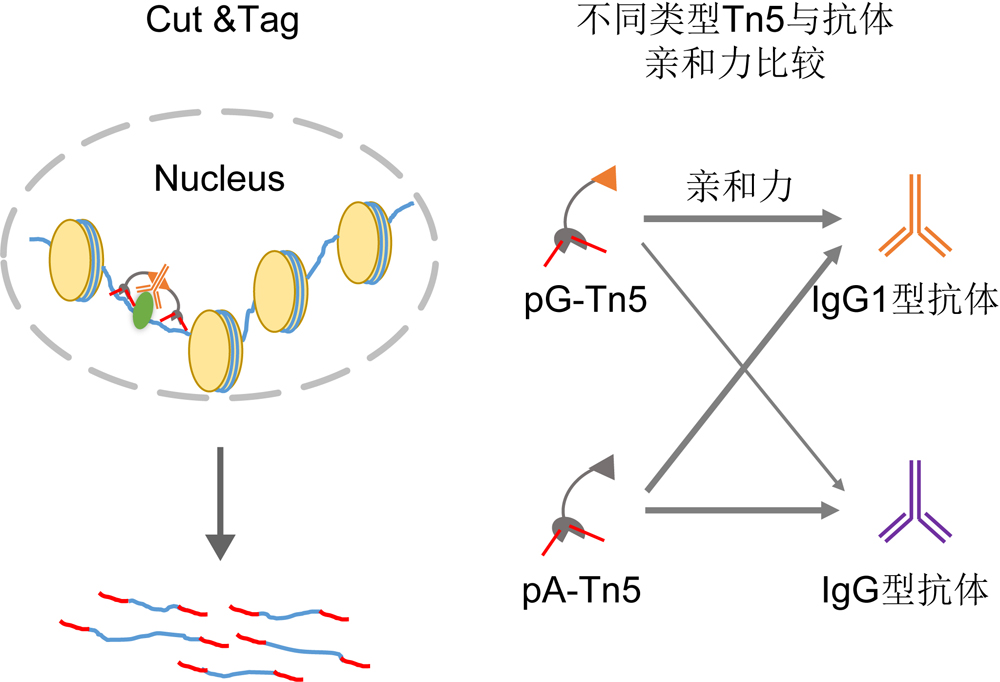

Optimization and Evaluation of Tn5 Transposase Fusion Protein in CUT&Tag
Received date: 2022-04-29
Accepted date: 2022-09-07
Online published: 2022-09-30
Tn5 is a bacterial transposon. The engineered Tn5 can efficiently tag DNA while adding the adapter sequences. Therefore, it has been widely used in the preparation of high-throughput sequencing libraries. Cleavage Under Target & Tagmentation (CUT&Tag) is an improved technology for studying the interaction between protein and DNA, which has the advantages of good repeatability, high signal-to-noise ratio, and easy operation. This technology uses Protein A (pA) or Protein G (pG) and Tn5 to form a fusion protein, which can locate specific antibodies (the antibody is used to identify the target protein) and break the DNA near the target site while introducing sequencing adapters. Then, DNA was extracted, followed by PCR amplification to obtain the sequencing library. However, different types of antibodies have different affinities for pA and pG, thus limiting the application of CUT&Tag for some antibodies. To overcome this limitation, the expression vector of pG-Tn5 was constructed by recombination, and pG-Tn5 recombinant protein was obtained by prokaryotic expression and affinity purification. We used RNA polymerase II (Pol II)-specific antibodies (Pol II Ser5P, mouse IgG1 and rabbit IgG) to compare the efficiency of pA-Tn5 and pG-Tn5 in library preparation of CUT&Tag in Arabidopsis. The results showed that the IgG1 antibody had higher affinity for pG-Tn5, and the quality of the constructed library was better when pG-Tn5 was used. The rabbit IgG antibody has comparable affinities to the two enzymes. A lower starting amount of plant material can be applicable in CUT&Tag. This study provides a reference for the selection of Tn5 fusion proteins against different antibodies in future CUT&Tag experiments.

Key words: ChIP; CUT&Tag; RNA polymerase II; Tn5
Shengyu Liu , Xiaobin Liu , Jiafu Zhu , Jing Su , Zhicheng Dong , Min Liu . Optimization and Evaluation of Tn5 Transposase Fusion Protein in CUT&Tag[J]. Chinese Bulletin of Botany, 2023 , 58(4) : 602 -611 . DOI: 10.11983/CBB22091
| [1] | 陈威, 杨颖增, 陈锋, 周文冠, 舒凯 (2019). 表观遗传修饰介导的植物胁迫记忆. 植物学报 54, 779-785. |
| [2] | 杜康兮, 沈文辉, 董爱武 (2018). 表观遗传调控植物响应非生物胁迫的研究进展. 植物学报 53, 581-593. |
| [3] | 王泓力, 焦雨铃 (2020). 染色质免疫共沉淀实验方法. 植物学报 55, 475-480. |
| [4] | 杨同文, 李成伟 (2014). 植物叶片衰老的表观遗传调控. 植物学报 49, 729-737. |
| [5] | Brahma S, Henikoff S (2019). RSC-associated subnucleosomes define MNase-sensitive promoters in yeast. Mol Cell 73, 238-249. |
| [6] | Buenrostro JD, Giresi PG, Zaba LC, Chang HY, Greenleaf WJ (2013). Transposition of native chromatin for fast and sensitive epigenomic profiling of open chromatin, DNA-binding proteins and nucleosome position. Nat Methods 10, 1213-1218. |
| [7] | Dancette OP, Taboureau JL, Tournier E, Charcosset C, Blond P (1999). Purification of immunoglobulins G by protein A/G affinity membrane chromatography. J Chromatogr B: Biomed Sci Appl 723, 61-68. |
| [8] | Di L, Fu Y, Sun YS, Li J, Liu L, Yao JC, Wang GB, Wu YL, Lao KQ, Lee RW, Zheng GH, Xu J, Oh J, Wang D, Xie XS, Huang YY, Wang JB (2020). RNA sequencing by direct tagmentation of RNA/DNA hybrids. Proc Natl Acad Sci USA 117, 2886-2893. |
| [9] | Dobin A, Davis CA, Schlesinger F, Drenkow J, Zaleski C, Jha S, Batut P, Chaisson M, Gingeras TR (2013). STAR: ultrafast universal RNA-seq aligner. Bioinformatics 29, 15-21. |
| [10] | Kaya-Okur HS, Wu SJ, Codomo CA, Pledger ES, Bryson TD, Henikoff JG, Ahmad K, Henikoff S (2019). CUT& Tag for efficient epigenomic profiling of small samples and single cells. Nat Commun 10, 1930. |
| [11] | Kharchenko PV, Tolstorukov MY, Park PJ (2008). Design and analysis of ChIP-seq experiments for DNA-binding proteins. Nat Biotechnol 26, 1351-1359. |
| [12] | Lindmark R, Thorén-Tolling K, Sj?quist J (1983). Binding of immunoglobulins to protein A and immunoglobulin levels in mammalian sera. J Immunol Methods 62, 1-13. |
| [13] | Lovell S, Goryshin IY, Reznikoff WR, Rayment I (2002). Two-metal active site binding of a Tn5 transposase synaptic complex. Nat Struct Biol 9, 278-281. |
| [14] | Martin M (2011). Cutadapt removes adapter sequences from high-throughput sequencing reads. EMBnet.Journal 17, 10-12. |
| [15] | Meers MP, Bryson TD, Henikoff JG, Henikoff S (2019). Improved CUT&RUN chromatin profiling tools. eLife 8, e46314. |
| [16] | Ouyang WZ, Zhang XW, Peng Y, Zhang Q, Cao ZL, Li GL, Li XW (2021). Rapid and low-input profiling of histone marks in plants using nucleus CUT&Tag. Front Plant Sci 12, 734679. |
| [17] | Picelli S, Bj?rklund ?K, Reinius B, Sagasser S, Winberg G, Sandberg R (2014). Tn5 transposase and tagmentation procedures for massively scaled sequencing projects. Genome Res 24, 2033-2040. |
| [18] | Ramírez F, Ryan DP, Grüning B, Bhardwaj V, Kilpert F, Richter AS, Heyne S, Dündar F, Manke T (2016). DeepTools2: a next generation web server for deep-sequencing data analysis. Nucleic Acids Res 44, W160-W165. |
| [19] | Schmidt D, Wilson MD, Spyrou C, Brown GD, Hadfield J, Odom DT (2009). ChIP-seq: using high-throughput sequencing to discover protein-DNA interactions. Methods 48, 240-248. |
| [20] | Skene PJ, Henikoff S (2017). An efficient targeted nuclease strategy for high-resolution mapping of DNA binding sites. eLife 6, e21856. |
| [21] | Tao XY, Feng SL, Zhao T, Guan XY (2020). Efficient chromatin profiling of H3K4me3 modification in cotton using CUT&Tag. Plant Methods 16, 120. |
| [22] | Thakur J, Henikoff S (2018). Unexpected conformational variations of the human centromeric chromatin complex. Genes Dev 32, 20-25. |
| [23] | Thorvaldsdóttir H, Robinson JT, Mesirov JP (2013). Integrative Genomics Viewer (IGV): high-performance genomics data visualization and exploration. Brief Bioinform 14, 178-192. |
| [24] | Wang LG, Wang SQ, Li W (2012). RSeQC: quality control of RNA-seq experiments. Bioinformatics 28, 2184-2185. |
| [25] | Zheng XY, Gehring M (2019). Low-input chromatin profiling in Arabidopsis endosperm using CUT&RUN. Plant Reprod 32, 63-75. |
/
| 〈 |
|
〉 |